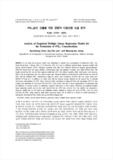

PARTNER
검증된 파트너 제휴사 자료
PM2.5농도 산출을 위한 경험적 다중선형 모델 분석
방대한 850만건의 자료 중 주제별로 만들수 있는 최적의 산출물을 해피 캠퍼스에서 체험 하세요 전문가의 지식과 인사이트를 활용하여 쉽고 폭넓게 이해하고 적용할수 있는 기회를 놓치지 마세요
10 페이지
최초등록일 2023.04.05
최종저작일
2017.08

-
 * 본 문서는 배포용으로 복사 및 편집이 불가합니다.
* 본 문서는 배포용으로 복사 및 편집이 불가합니다.
미리보기
서지정보
· 발행기관 : 한국지구과학회
· 수록지 정보 : 한국지구과학회지 / 38권 / 4호
· 저자명 : 추교황, 이규태, 정명재
초록
본 연구에서는 서울지역의 지상 미세먼지(PM2.5) 농도를 산출하기 위하여 경험적인 모델들을 개발하였다. 연구에 이용한 자료는 2012년 1월 1일부터 2013년 12월 31일까지이며 Terra와 Aqua위성의 MODIS센서에서 산출되는 에어로 졸 광학두께, 옹스트롬 지수, 기상변수들과 행성경계층두께와 관련된 6개의 다중 선형 회귀모델들의 차이를 분석하였다. 그 결과 에어로졸 광학두께와 옹스트롬 지수, 상대습도, 풍속, 풍향, 행성경계층두께, 기온 자료를 입력 자료로 사용한 M6모델이 가장 좋은 결과를 보였다. 통계적인 분석에 따르면 M6 모델을 사용하여 계산된 PM2.5와 관측된 PM2.5농도 사 이의 결과는 상관계수(R=0.62)와 평균제곱근오차(RMSE=10.70 μg m−3)이다. 또한 산출된 계절별 지표면 PM2.5농도는 여름철(R=0.38)과 겨울철(R=0.56)보다 봄(R=0.66)과 가을철(R=0.75)에 상대적으로 더 좋은 상관 관계를 보였다. 이러한 결과는 에어로졸 광학두께의 계절별 관측 특성으로 인한 것으로써 다른 계절에 비하여 여름과 겨울철 에어로졸 광학두께 관측이 구름과 눈/얼음 표면에 의한 관측 제한과 오차를 가져온 것으로 분석되었다. 따라서 본 연구에서 사용한 경 험적 다중선형회귀 모델은 위성에서 산출된 에어로졸 광학두께 자료가 지배적인 변수로 작용하며 PM2.5산출 결과들을 향상시키기 위해서는 추가적인 기상 변수를 이용해야 할 것이다. 또한 경험적 다중선형회귀 모델을 이용하여 PM2.5를 산출한 결과는 인공위성 자료로부터 대기환경 감시를 가능하게 하는 방법이 될 수 있어 유용할 것이다.영어초록
In this study, the empirical models were established to estimate the concentrations of surface-level PM2.5 over Seoul, Korea from 1 January 2012 to 31 December 2013. We used six different multiple linear regression models with aerosol optical thickness (AOT), Ångström exponents (AE) data from Moderate Resolution Imaging Spectroradiometer (MODIS) aboard Terra and Aqua satellites, meteorological data, and planetary boundary layer depth (PBLD) data. The results showed that M6 was the best empirical model and AOT, AE, relative humidity (RH), wind speed, wind direction, PBLD, and air temperature data were used as input data. Statistical analysis showed that the result between the observed PM2.5 and the estimated PM2.5 concentrations using M6 model were correlations (R=0.62) and root square mean error (RMSE=10.70 μg m−3). In addition, our study show that the relation strongly depends on the seasons due to seasonal observation characteristics of AOT, with a relatively better correlation in spring (R=0.66) and autumntime (R=0.75) than summer and wintertime (R was about 0.38 and 0.56). These results were due to cloud contamination of summertime and the influence of snow/ice surface of wintertime, compared with those of other seasons. Therefore, the empirical multiple linear regression model used in this study showed that the AOT data retrieved from the satellite was important a dominant variable and we will need to use additional weather variables to improve the results of PM2.5. Also, the result calculated for PM2.5 using empirical multi linear regression model will be useful as a method to enable monitoring of atmospheric environment from satellite and ground meteorological data.참고자료
· 없음태그
-
자료후기
-
자주묻는질문의 답변을 확인해 주세요

꼭 알아주세요
-
본 학술논문은 (주)코리아스칼라와 각 학회간에 저작권계약이 체결된 것으로 AgentSoft가 제공 하고 있습니다.
본 저작물을 불법적으로 이용시는 법적인 제재가 가해질 수 있습니다. -
해피캠퍼스는 구매자와 판매자 모두가 만족하는 서비스가 되도록 노력하고 있으며, 아래의 4가지 자료환불 조건을 꼭 확인해주시기 바랍니다.
파일오류 중복자료 저작권 없음 설명과 실제 내용 불일치 파일의 다운로드가 제대로 되지 않거나 파일형식에 맞는 프로그램으로 정상 작동하지 않는 경우 다른 자료와 70% 이상 내용이 일치하는 경우 (중복임을 확인할 수 있는 근거 필요함) 인터넷의 다른 사이트, 연구기관, 학교, 서적 등의 자료를 도용한 경우 자료의 설명과 실제 자료의 내용이 일치하지 않는 경우
“한국지구과학회지”의 다른 논문도 확인해 보세요!
-
드론 기반 항공자력탐사 시스템을 이용한 철광산 탐사 적용성 연구 12 페이지
드론을 이용한 신뢰성 있는 항공자력탐사 수행을 위해서 자력탐사 시스템과 드론 시스템을 구성하여 철광산 지 역 자력 탐사에 적용하였다. 드론에 실리는 자력탐사 시스템은 Bartington사의 플럭스게이트 자력계 Mag639를 센서로 사용하고, A/D convertor를 이용하여 태블릿PC에 자력값이 저장되도록 구성하였다. 드론의 비행 컨트롤 모듈로는 확장 성.. -
중력 변화율 텐서를 이용한 선형 이상체 위치 결정 6 페이지
한 개 측선에서 얻어진 중력 변화율 텐서 자료를 이용하여 주향과 경사를 가지는 선형 이상체의 위치를 결정하 는 알고리즘을 제시하였다. 기존에 연구된 중력 변화율 텐서를 이용한 선형 이상체의 주향과 경사를 결정하는 방법을 발전시켜서, 선형 이상체의 주향과 경사를 결정한 이후 이상체의 위치를 결정하는 알고리즘을 개발하였다. 선형 이상체 의 주향과 경사는 2차원.. -
다중선형회귀모형에 의한 지표면 광대역 방출율 산출 14 페이지
이 연구에서는 Earth Observing System Terra 위성에 탑재된 Moderate Resolution Imaging Spectroradiometer (MODIS) 협대역 방출율(채널 29, 30, 31) 자료와 다중선형회귀모형을 이용하여 지표면 광대역 방출율을 추정하였다. 다중선형회귀모형 도출 및 검증을 위한 분광 방출율 자료는 MODIS U.. -
보령 지역의 후기 트라이아스기 아미산층에서 산출된 화석 강도래 (Plecoptera) 유충의 분류와 생태학적 의미 10 페이지
최근 보령 지역의 후기 트라이아스기 아미산층에서 다량의 화석 강도래 유충이 발견되었다. 이들의 유충은 그 형태적 특징에 의해 Platyperlidae과, Baleyopterygidae과, Siberioperlidae과 등으로 분류되었다. 이 중 양적으로 가장 많 이 발견되는 종류는 Baleyopterygidae과의 화석 강도래이다. 이러한 사실은 강도래가 .. -
과학적 모델의 사회적 구성 수업을 적용한 야외지질학습에서 나타나는 조별 모델 구성과정 이해: 제약조건을 중심으로 18 페이지
본 연구의 목적은 과학적 모델의 사회적 구성 수업을 적용한 야외지질학습에서 학생들이 만드는 조별 모델 구 성 과정에 대해 제약조건을 중심으로 이해하는 것이다. S 영재원 지구과학분과 3조, 12명의 학생들을 대상으로 진행하 였다. ‘관악산은 어떻게 형성되었을까?’를 주제로 야외지질답사 2차시, 과학적 모델의 사회적 구성 수업 3차시로 진행하 였다. 조별 모..
문서 초안을 생성해주는 EasyAI

